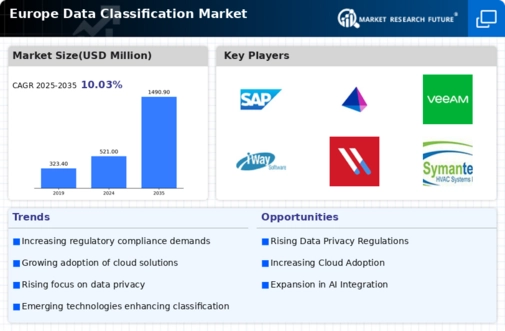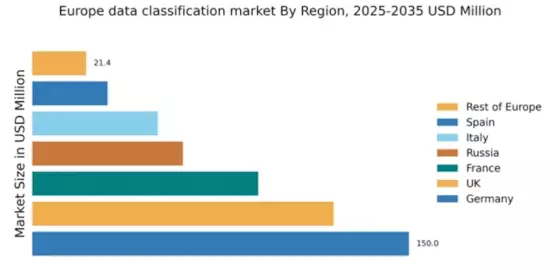Rising Data Privacy Concerns
The increasing awareness of data privacy issues among consumers and businesses is a pivotal driver in the data classification market. In Europe, stringent regulations such as the General Data Protection Regulation (GDPR) have heightened the need for organizations to classify and manage data effectively. This regulatory framework mandates that companies implement robust data classification systems to ensure compliance, thereby reducing the risk of data breaches and associated penalties. As a result, organizations are investing in advanced data classification solutions to safeguard sensitive information. The market for data classification solutions in Europe is projected to grow at a CAGR of approximately 15% over the next five years, reflecting the urgency to address privacy concerns and enhance data governance.
Growing Cybersecurity Threats
The escalating threat of cyberattacks is a critical driver for the data classification market in Europe. As organizations face increasing risks from data breaches and cyber threats, the need for effective data classification becomes essential to protect sensitive information. Data classification helps organizations identify and prioritize data based on its sensitivity, enabling them to implement appropriate security measures. The cybersecurity market in Europe is projected to reach €40 billion by 2026, highlighting the urgency for businesses to invest in data classification solutions as part of their overall cybersecurity strategy. This trend underscores the importance of classifying data to mitigate risks and enhance organizational resilience.
Adoption of Cloud Technologies
The shift towards cloud computing is significantly influencing the data classification market in Europe. As organizations increasingly migrate their operations to the cloud, the need for effective data classification becomes paramount. Cloud environments often host sensitive data, making it essential for businesses to implement classification protocols to protect this information. The European cloud services market is expected to reach €100 billion by 2025, indicating a robust growth trajectory. This growth is likely to drive investments in data classification solutions that can seamlessly integrate with cloud platforms, ensuring that data is appropriately classified and secured in accordance with regulatory requirements.
Emergence of Advanced Analytics
The rise of advanced analytics tools is reshaping the data classification market in Europe. Organizations are increasingly leveraging analytics to derive insights from their data, necessitating effective classification to ensure data quality and relevance. Advanced analytics solutions require well-structured data, which can only be achieved through proper classification. As businesses seek to enhance their decision-making processes, the demand for data classification solutions that support analytics initiatives is expected to grow. The market for advanced analytics in Europe is projected to expand at a CAGR of 20% over the next few years, further driving the need for robust data classification frameworks.
Increased Data Volume and Complexity
The exponential growth of data generated by organizations in Europe is driving the demand for effective data classification solutions. With the rise of big data, businesses are faced with the challenge of managing vast amounts of structured and unstructured data. This complexity necessitates sophisticated data classification systems that can efficiently categorize and manage data assets. The data classification market is responding to this challenge by offering solutions that leverage machine learning and automation to streamline data management processes. It is estimated that by 2026, the volume of data generated in Europe will reach 100 zettabytes, further emphasizing the need for effective classification strategies to ensure data accessibility and compliance.


















Leave a Comment